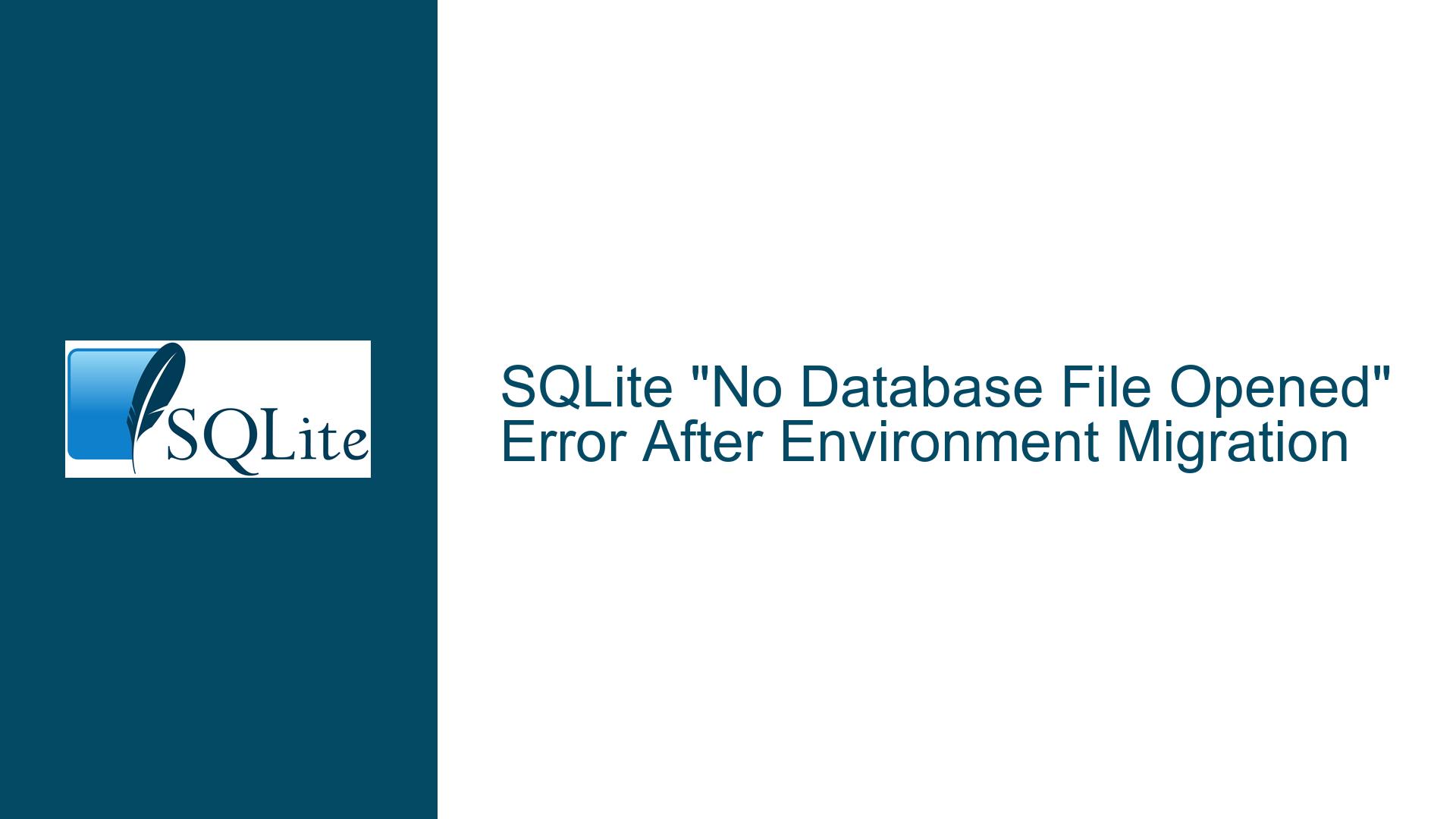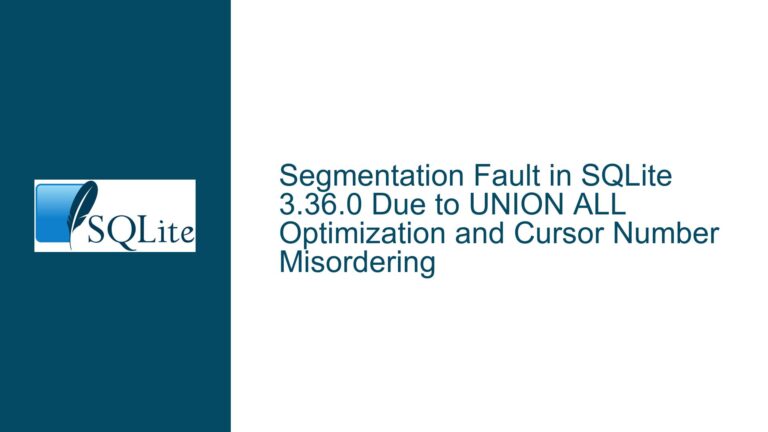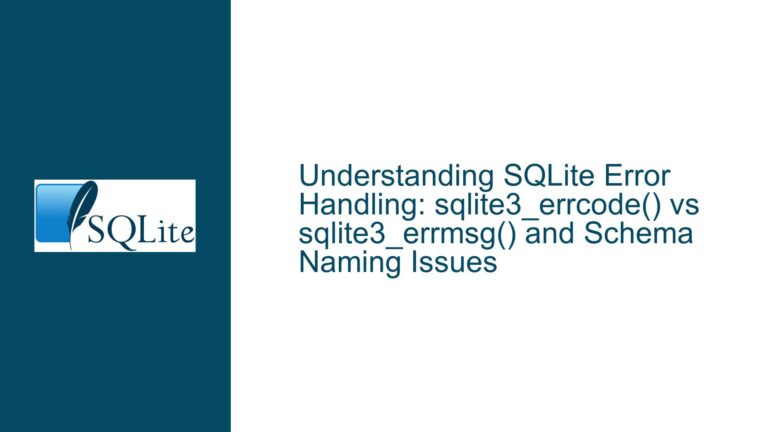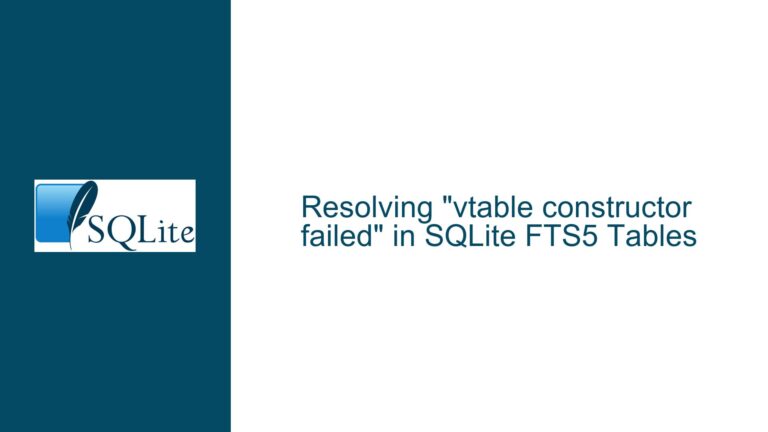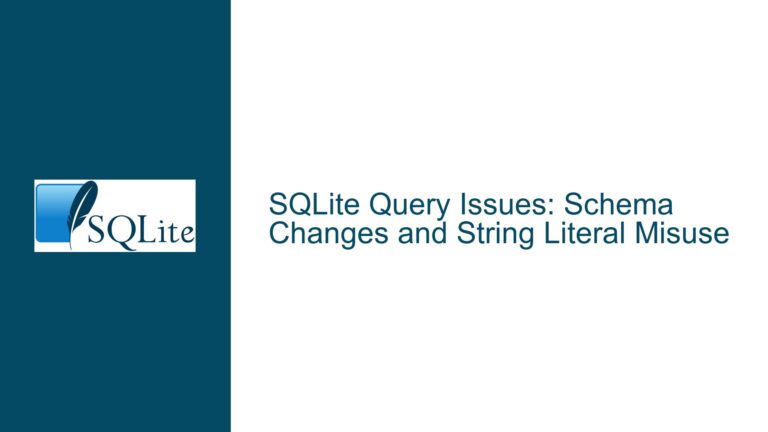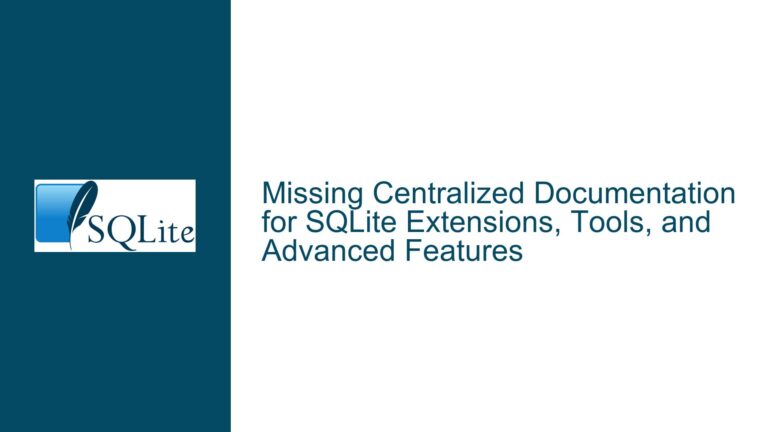SQLite “No Database File Opened” Error After Environment Migration
Database Connection Failure Due to Path or Permission Misconfiguration
Issue Overview: Environment Migration Causes SQLite File Access Failures
When transitioning a Python application using SQLite databases between computing environments—particularly when migrating to a virtual machine (VM)—a common failure mode manifests as the "No database file opened" error. This error indicates that SQLite cannot locate or access the specified database file through the provided connection string. The root cause typically lies in discrepancies between file system paths, permissions configurations, or environmental assumptions that were valid in the original development machine but become invalid post-migration.
Key symptoms include:
- Inability to open existing database files that functioned correctly in the source environment
- Failure to create new database files in the target environment
- Consistent error messages despite confirming the presence of database files in expected directories
The problem is exacerbated when developers hardcode absolute file paths, neglect to handle operating system (OS)-specific path formatting, or assume uniform directory structures across environments. SQLite relies on the host OS’s file system APIs to resolve paths and enforce permissions. Any mismatch between the application’s expected file hierarchy and the VM’s actual hierarchy—or insufficient file access rights—will prevent SQLite from initializing a database connection.
Possible Causes: Path Resolution, Permissions, and File Creation Logic
Absolute vs. Relative Path Mismatches
Applications often fail post-migration due to hardcoded absolute paths referencing user-specific directories (e.g., C:\Users\OldUser\Documents\app.db on Windows or /home/olduser/app.db on Linux). Virtual machines frequently use different usernames or directory structures, rendering these paths invalid. Even when relative paths are used, the working directory of the Python process might differ between environments. For example, a script executed from an IDE may inherit the project root as its working directory, while the same script run via a system service might default to / or C:\Windows\System32.
File System Permission Denials
SQLite requires read/write permissions on both the database file and its containing directory. Virtual machines—especially those running Linux—may enforce stricter default permissions than development machines. If the VM user account lacks write access to the target directory, SQLite cannot create or modify database files. This issue is prevalent when databases are stored in system-protected directories (e.g., /var/lib on Linux) without proper privilege escalation (e.g., sudo).
Implicit File Creation Assumptions
SQLite’s sqlite3.connect() function behaves differently depending on connection flags:
- Mode
rw: Fails if the file does not exist - Mode
rwc: Creates the file if it does not exist - Mode
ro: Opens the file in read-only mode
Applications that omit the c (create) flag in environments where the database file hasn’t been initialized will trigger the "No database file opened" error. This is common when developers assume the database file will always exist (e.g., after a git clone) but forget to include initialization logic for fresh environments.
Troubleshooting Steps: Validating Paths, Permissions, and Connection Parameters
Step 1: Verify Absolute File Paths via Debug Output
Modify the Python code to print the absolute path of the database file before invoking sqlite3.connect(). This exposes discrepancies between expected and actual paths:
import os
import sqlite3
db_path = "data/app.db" # Example relative path
abs_db_path = os.path.abspath(db_path)
print(f"Attempting to connect to database at: {abs_db_path}")
try:
conn = sqlite3.connect(abs_db_path)
except sqlite3.Error as e:
print(f"SQLite error: {e}")
Execute the script and compare the printed path against the VM’s actual file hierarchy. Use terminal commands like ls -l <path> (Linux) or dir <path> (Windows) to confirm the file exists at the specified location.
Step 2: Test File System Access Independently of SQLite
Isolate file system issues by attempting to create, write to, and read from the target path using standard Python file operations:
test_path = os.path.abspath("data/test.txt")
try:
# Attempt write
with open(test_path, "w") as f:
f.write("test")
# Attempt read
with open(test_path, "r") as f:
content = f.read()
print(f"File access successful: {content}")
except IOError as e:
print(f"File access failed: {e}")
If this test fails, the problem lies outside SQLite—likely due to nonexistent directories or insufficient permissions. Resolve these issues before revisiting database connectivity.
Step 3: Enforce Directory Creation and Permission Hierarchies
Ensure all directories in the database file’s path exist and have correct permissions. Use os.makedirs() with exist_ok=True to create directories recursively:
db_dir = os.path.dirname(abs_db_path)
os.makedirs(db_dir, mode=0o755, exist_ok=True) # Linux-style permissions
On Linux VMs, verify directory ownership and permissions using:
chmod -R 755 /path/to/data # Allow read/write/execute for owner, read/execute for others
chown -R $USER:$USER /path/to/data # Set ownership to current user
Step 4: Use Canonicalized Paths with URI Formatting
SQLite supports URI-based filenames, which improve cross-platform consistency. Modify the connection string to use a URI with explicit mode=rwc parameters:
conn = sqlite3.connect(f"file:{abs_db_path}?mode=rwc", uri=True)
This ensures SQLite attempts to create the file if missing, while URI formatting handles OS-specific path separators (e.g., backslashes on Windows).
Step 5: Validate SQLite Connection Flags and Error Handling
Explicitly handle SQLite connection errors to distinguish between missing files and permission issues:
try:
conn = sqlite3.connect(abs_db_path, timeout=10)
except sqlite3.OperationalError as e:
if "unable to open database file" in str(e):
print("File not found or permissions denied")
else:
print(f"Other SQLite error: {e}")
Step 6: Cross-Validate with In-Memory Databases
Temporarily replace the file-based database with an in-memory database to confirm SQLite functionality:
conn = sqlite3.connect(":memory:")
# Perform schema creation and data operations
If the in-memory database works, the issue is definitively tied to file system access rather than application logic.
Step 7: Audit Virtual Machine File Sharing and Mount Configurations
When using shared folders between host and VM (e.g., VirtualBox Shared Folders), ensure they’re mounted with full read/write access. For example, VirtualBox requires manual configuration of shared folder permissions:
sudo mount -t vboxsf -o rw,uid=$USER,gid=$USER shared_folder /path/to/mount
Step 8: Utilize SQLite CLI for Low-Level Diagnostics
Use the sqlite3 command-line interface (CLI) to manually test database access:
sqlite3 /path/to/database.db "SELECT sqlite_version();"
If the CLI fails with similar errors, the problem is environmental rather than code-related. Success in the CLI suggests bugs in the Python application’s path handling.
Step 9: Profile File System Operations with strace/dtrace
On Linux, use strace to trace file system calls made by the Python process:
strace -e trace=file -o sqlite_trace.log python3 app.py
Inspect the log for ENOENT (No such file or directory) or EACCES (Permission denied) errors related to the database file.
Step 10: Reinitialize the Database with Schema Scripting
If file corruption is suspected, export the schema and data from the original database:
sqlite3 original.db .schema > schema.sql
sqlite3 original.db .dump > dump.sql
Reimport in the VM:
sqlite3 new.db < schema.sql
sqlite3 new.db < dump.sql
Update the application to reference new.db and test connectivity.
By systematically validating paths, permissions, and SQLite connection parameters, developers can resolve "No database file opened" errors arising from environment migrations. The key is to eliminate assumptions about file system state and enforce explicit directory creation, permission management, and connection flagging.
